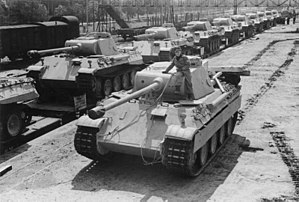| Panzerkampfwagen V Panther | |
|---|---|
 Panther Ausf. D tanks, 1943 | |
| Type | Medium tank |
| Place of origin | Nazi Germany |
| Service history | |
| In service |
|
| Used by |
|
| Wars | World War II |
| Production history | |
| Designer | MAN AG |
| Designed | 1942 |
| Manufacturer | MAN, Daimler-Benz, MNH |
| Unit cost | 117,100 ℛ︁ℳ︁ (without weapons, optics, or radio) 143,912 ℛ︁ℳ︁ (combat ready)[1][2] 2,000 Man hours[3] |
| Produced | 1943–1945 (1946–49 postwar for the British Army) |
| No. built | about 6,000[4] |
| Variants |
|
| Specifications | |
| Mass | 44.8 tonnes (44.1 long tons; 49.4 short tons)[5] |
| Length |
|
| Width |
|
| Height | 2.99 m (9 ft 10 in) |
| Crew | 5 (driver, radio operator/hull machine gunner, commander, gunner, loader) |
| Armour | 16–100 mm |
Main armament |
|
Secondary armament | |
| Engine | V12 Maybach HL230 P30 petrol engine[5] 700 PS (690 hp, 515 kW) |
| Power/weight | 15.39 PS (11.5 kW/tonne) (13.77 hp/ton) |
| Transmission | ZF AK 7-200. 7 forward 1 reverse[5] |
| Suspension | double torsion bar, interleaved road wheels |
| Fuel capacity | 730 litres (160 imp gal; 190 US gal) |
Operational range |
|
| Maximum speed |
|
The Panther tank, officially Panzerkampfwagen V Panther (abbreviated Pz.Kpfw. V) with ordnance inventory designation: Sd.Kfz. 171, is a German medium tank of World War II. It was used in most European theatres of World War II from mid-1943 to the end of the war in May 1945.
The Panther was intended to counter the Soviet T-34 medium tank and to replace the Panzer III and Panzer IV. Nevertheless, it served alongside the Panzer IV and the heavier Tiger I until the end of the war. While having essentially the same Maybach V12 petrol (690 hp) engine as the Tiger I, the Panther had better gun penetration, was lighter and faster, and could traverse rough terrain better than the Tiger I. The trade-off was weaker side armour, which made it vulnerable to flanking fire, and a weaker high explosive shell. The Panther proved to be effective in open country and long-range engagements.[8] The Panther had excellent firepower, protection and mobility, though early variants suffered from reliability issues.[9] The Panther was far cheaper to produce than the Tiger I. Key elements of the Panther design, such as its armour, transmission, and final drive, were simplifications made to improve production rates and address raw material shortages.
The Panther was rushed into combat at the Battle of Kursk in the summer of 1943 despite numerous unresolved technical problems, leading to high losses due to mechanical failures. Most design flaws were rectified by late 1943 and early 1944, though the Allied bombing of production plants in Germany, increasing shortages of high-quality alloys for critical components, shortage of fuel and training space, and the declining quality of crews all impacted the tank's effectiveness. Though officially classified as a medium tank, at 44.8 metric tons the Panther was closer in weight to contemporary foreign heavy tanks. The Panther's weight caused logistical problems, such as an inability to cross certain bridges; otherwise, the tank had a very high power-to-weight ratio which made it highly mobile.
The naming of Panther production variants did not follow alphabetical order, unlike most German tanks - the initial variant, Panther "D" (Ausf. D), was followed by "A" and "G" variants.
- ^ Zaloga 2015, Armored Champion p. 37
- ^ Walter J Spielberger 1993, Panther & Its Variants p. 232.
- ^ Walter J Spielberger 1993, Panther & Its Variants p. 244.
- ^ Cite error: The named reference
Jentz284was invoked but never defined (see the help page). - ^ a b c d e f Doyle and Jentz 1997, p. 28.
- ^ Cite error: The named reference
Panzer Tracts 5-1was invoked but never defined (see the help page). - ^ Wehrtechnische Gemeinschaft des VDI in Berlin 1945 February 7.
- ^ Zaloga 2015, Armored Champion p. 202
- ^ Panther & Its Variants (The Spielberger German Armor & Military Vehicles) by Walter J. Spielberger page 229.